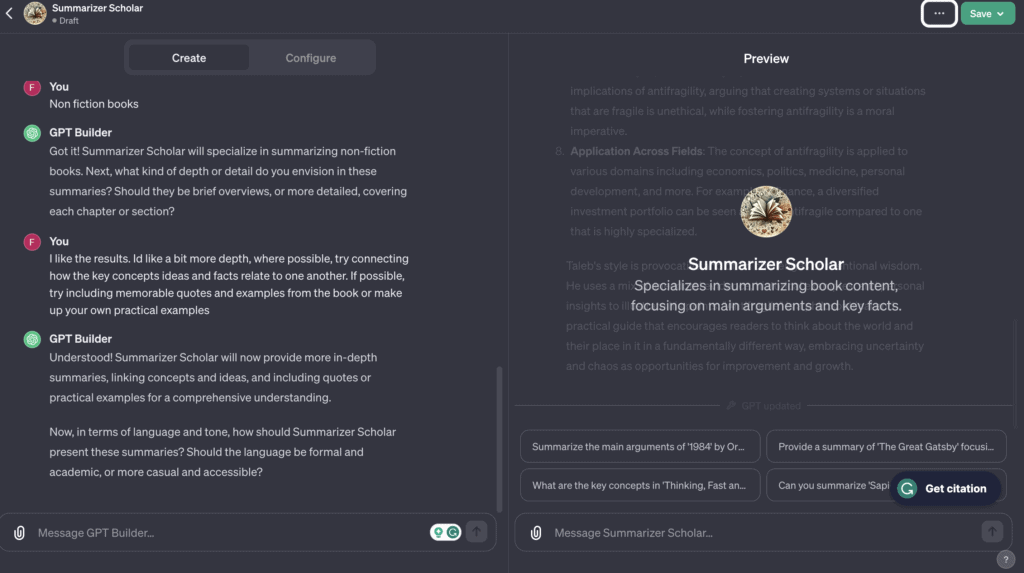What’s a GPT?
OpenAI recently introduced its take on AutoGPTs, choosing the creative name “GPTs”. These are custom versions of ChatGPT that can be created, shared, and used by ChatGPT Plus and Enterprise users. Can these solve world hunger? They are not that autonomous yet, but they are good. A couple of reasons why:
There was a lot of hype when ChatGPT first took off surrounding what many called AutoGPTs. What do people mean by these? Imagine AI as a fully autonomous agent that you assign a goal and it sets off to achieve it, crafting its prompts in the process. Want to solve world hunger? No problem. The AI will start work on raising funding, coordinating with others, and so on.
- They make sharing structured prompts easy. Using the no-code builder, you can also easily build structured prompts.
- You can connect them to your knowledge base by uploading documents (think internal documents, databases, etc.) and also connect them to APIs of other services.
GPTs are thus easy to make and powerful. The fact that they are easy to share is also going to be useful for all kinds of organizations and collaborative projects. This is just the start. While not truly “autonomous” at the moment, once connected to multiple services and equipped with the right prompts, these will be able to achieve much more. This also implies some risks. As GPTs become more autonomous, and connected to an increasing number of systems, handling more sensitive data, the potential for misuse will be a growing concern.
Making a GPT
It is super easy to create GPTs, using OpenAI’s own GPT Builder (pictured on the left). Users only need to describe what they’d like the GPT to do. GPT builder will then suggest a name and generate a profile picture. You can test it out after making each change by using the preview (pictured on the right).

The secret sauce lies in the structure prompt hidden in the configure tab. This is where you can also upload your documents, connect the GPT to other services, and enable it to use OpenAI’s Dall E, Code Interpreter, and Web Browsing. As an example, I created a GPT for making better summaries of books. GPT builder created this structured prompt after a couple of minutes of talking to it.
Summarizer Scholar provides in-depth summaries of non-fiction books, linking concepts and ideas with memorable quotes and practical examples. After delivering a summary, it will prompt the user to ask if they would like to expand on any points. If the user requests more depth, Summarizer Scholar will delve deeper, analyzing assumptions made in the book, the chain of logic, and both positive and normative arguments. It will also provide related quotes, facts, practical examples, and engaging tidbits, including humorous or interesting elements. This approach ensures a thorough understanding and adds an interactive dimension to the summaries.The result was a significant improvement over just asking GPT to summarize a book without any additional input. Well, to me anyways. The “Summarizer Scholar” focuses on key concepts and facts from the requested book. In addition, it provides users with interesting quotes and practical examples, and is more interactive, asking follow-up questions after each answer. (If you want to check it out and compare for yourself, you can access it here)
Be mindful of the limitations though. First of all, it has all the faults that we have come to expect from ChatGPT. Mainly hallucinating answers to things it doesn’t know. Nothing changes with GPTs here. It also won’t perfectly adhere to all the rules you make for it. I’ve tried creating a Dungeon Master GPT that would act according to the DnD rulebook, but it frequently forgot about some of the rules or was easily persuaded to break them.
What’s the future of custom GPTs?
GPTs are powerful, easy to use, and share. They are far from being flawless true agents, yet. I think it is easy to imagine a future where GPTs become an integral part of everyday life though. Connected to your data, and services, they will be able to write emails for you, manage your portfolio, send job applications, control your calendar, and a plethora of other things. Perhaps, with time, they’ll be able to work on even more abstract goals for you. (Such as a GPT that you instruct to make you money, and it sets off to try different things.) As their autonomy grows, and with it our reliance (or over-reliance?), it will be important to keep ahead of any risks that their behavior might cause. Stay nimble.

